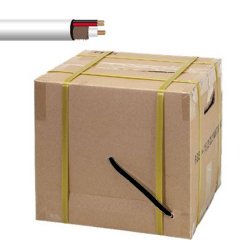 If you have a “wired” digital video system, you’ll want to make sure you have the correct security camera cables for it. In this article we’ll take a look at the most common type of security camera cable and its connectors.
If you have a “wired” digital video system, you’ll want to make sure you have the correct security camera cables for it. In this article we’ll take a look at the most common type of security camera cable and its connectors.
Digital video security cameras generally require two types of cable; one for video transmission of the camera to the DVR (Digital Video Recorder) and one for the power supply for the camera from a power supply source.
The most common security camera cable used today is the RG-59/U. This is a coaxial cable designed specifically for low-power video signals. Historically speaking, the name of the cable originates from the U.S. military. RG-59 designated the type of cable and the “U” stood for general utility use. However, the “RG” (which stood for “Radio, General”) component is no longer part of military standards, however the name use has remained, generally without the “/U” designation.
RG-59 security camera cable has a unique characteristic that makes it a good match for use with video transmissions. It has the same impedance as an antenna, such as the “rabbit ears” type that was used on televisions. This impedance of 75 ohms makes the cable a good choice for radio frequency transmissions for televisions, DVRs, and security camera video. RG-59 is smaller than typical cable television cable, RG-6, and is therefore less obtrusive and easier to manipulate.
However, RG-59 has a tendency toward high-frequency losses over long distances (greater than RG-6 for example) but 750 feet seems to be a generally agreed upon length before significant losses appear. These can also be corrected with drop amplifiers or active (powered) baluns to boost signals. For most security camera systems applications, RG-59 coaxial cable works well.
The RG-59 security camera cable consists of an outer plastic sheath (the colored cover or jacket of the cable), followed by a copper braid shield (it looks like a mesh or netting of fine wire), underneath which is an inner dielectric insulator (often looks like a milky white thick plastic material somewhat like a drinking straw) that contains a copper-plated or solid copper (better performance) center wire core.
RG-59 cable is usually fitted with one of three different types of connector; F connectors (used most commonly for cable television applications), RCA plugs (often used by DVD players), and BNC connectors. By far the most common type of security camera cable connector is the BNC.
The BNC connector provides a means of connection for both the shield and core of the cable. The connector has “male” and “female” plug types that when inserted together and twisted properly, stay locked together. In fact “BNC” stands for the bayonet like locking mechanism (B), and Paul Neill (N) and Carl Concelman (C) it’s inventors.
Security Camera King offers three different types of BNC connectors based on how they attach to the RG-59 cable. Connectors are fastened to the security camera cables either by twisting on, crimping, or compression. Twisting is the simplest and requires no additional tools once the wire is stripped and trimmed. Crimping, when done properly, generally holds the connector to the cable better but requires the use of a crimping tool. The best connection that provides the greatest strength is the compression BNC and it requires a compression tool.
Security cameras also require a power supply cable. This is normally standard 18 gauge copper wire with plastic insulation. The power for most security cameras is low voltage DC current of 12 volts or low voltage AC current of only 24 volts and this wire is suitable for carrying the power supply of either. The power supply cable that terminates at the security camera end usually does so using either screw terminals for each wire (often for AC) or a 2.5 mm female type power plug (often for DC) with a positive center.
Security Camera King offers complete security camera systems that include security camera cables for both power and video transmission. We offer pre-cut lengths of video and power supply cable with connectors already installed for “plug n play” use.
For applications with differing distances of cameras from the DVR, we offer bulk Siamese RG-59/18-2 cable with twist-on connectors. This cable consists of both the RG-59 video transmission cable and the 18 gauge 2-wire power supply cable. One cable means one run per camera saving you time and work.
There also offer other types of less common security camera cables. Check our Web catalog for more information.
